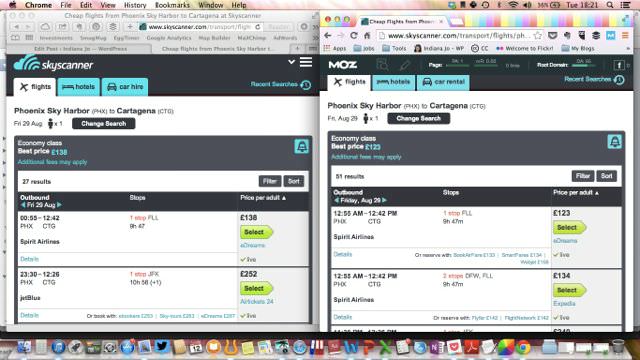Ready, set, go.
Have you ever been to an ecommerce site, like an airline or hotel finder, checked the prices and when you returned to make your booking found that the prices had gone up? Or, have you found that you’ve gone to book a rail or air ticket a few days before departure to find that prices are through the roof? Chances are you’ve probably experienced dynamic pricing.
But what is dynamic pricing?
Dynamic pricing is ‘loosely’ based on supply and demand. For instance, if we take an airline who have a bunch of flights going to Fiji for $500 and a competitor airline has them for $450 they may choose to change their prices during this time to meet the market. ‘Well that’s pretty obvious’ I hear you cry! Yes, it is. However, getting more complicated with dynamic pricing strategies could be based on time of day, day of the week, month and celebrations such as Christmas which means prices will fluctuate to meet supply and demand. Often AB testing will be done to see if something is more likely to sell for one price than another, what time of day people are prepared to pay more and what’s the highest price people will pay.
Tip: Clear your cache to remove your browsing history.
King of pricing.
Ecommerce giant Amazon have a well established dynamic pricing model that has seen them increase profits tenfold since implementation. They position themselves as having ‘consistently low prices’, however, this may not always be true. Just recently they got into trouble for ‘random price testing’ on their website where a whole bunch of angry customers demanded refunds who had been charged differing amounts for the same product. Another example of dynamic pricing from Amazon was a TV that they were selling for $400 one day that changed price consistently over a period of time based on what competitor pricing was doing for the same product. On Black Friday it dropped to an all time low of $250. However, during that Black Friday sale the cost of an HDMI cable went through the roof!
They’re watching you.
Dynamic pricing comes in many different forms. For instance, when you’re logged in to your favourite online shopping account, have you noticed that prices have gone up since you first started purchasing or have they gone down? Based on your purchase history, propensity to purchase at a certain level and the supply and demand at the time could all mean a price rise or a price drop in the products you purchase. You may have also signed up to receive price alerts only to find they never drop that low. I have been subject to this and ended up grabbing what I ‘thought’ was the best deal as the fluctuations were so tiny. I wonder if I’d waited a while or used someone else’s laptop to book if the prices would have been any different?
So how could YOU use this?
Fundraisers are well versed with driving people online to make a donation, but what if you were to use some of the dynamic pricing tactics to help increase your online donations? Am I mad? Probably.
How you can test and learn from dynamic pricing:
- Do some AB split testing with differing dollar amounts and see what bites you get
- Look at your data and find some trends for times of day, dollar amounts that people are most receptive to. If you usually get most of your donations with an average of $120 at 10am increase this amount and make that the minimum donation amount. And if you only get a few donations of $50 at 7pm decrease it to $45 and see if you get any takers than usual. Have a friendly word with your IT department/web developer (you will need some fancy code ad software) to see if you’re able to implement a dynamic donation page based on time of day etc.
It’s all in the testing
So you have a few tricks up your sleeve and now all you need to do is put them to work. Start off with some small changes to see what results you get and keep optimising. Sometimes being just a little bit creative can pay dividends. I’d love to know your thoughts on some of these ideas.




